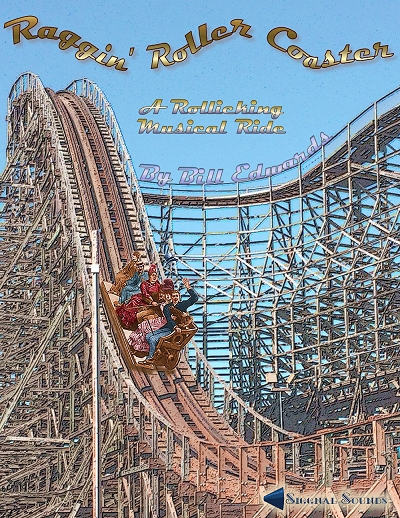
|
William G. Edwards (Within the Past Century to No Time Soon) | |
 Selected Covers (Hover to View) Selected Covers (Hover to View) | |
|
Orient's Appalachian Express
Pear Blossoms The Piano Tuner's Nightmare Pride of the Prairie The Purple Chicken Rag The Radio's Gone Silent Ragapples Raggin' Roller Coaster Ragtime Bobolink The Ragtime Pamela Snuggle Pup Spanish Fandango Sweetest Skunk in the Hollow The Tuxedo Cat Rag The Wiener Schnitzel Rag | |
Being the type of person who wants to be pretty good at everything rather than regarded the best at any one thing, and also because I like having my hands on every possible aspect of what I do, I slowly became involved in producing cover art for my own music. I had some art training during my regular secondary school education, and got involved in graphic arts in college, with more emphasis on design than painting or rendering. I have also studied animation art, again not the same as static art forms. So I went into this with at least some notion of an artistic eye as well as practical real world experience in drawing that went beyond paint by numbers (although I did pretty good on those).


Initially my artistic production was limited to cassette covers in the 1980s, some done on one of the early models of the Macintosh computer. But as the tools became more sophisticated, I found that I was able to produce interesting cassette/CD covers as well as those for sheet music. On a very primitive graphics rendering program I was able to replicate a faux-Schirmer cover for Hanon Rag on an early Tandy computer in 1985. Once computer generated (CG) art became a legitimate form both in movies and in real world graphics, I felt less inhibited about my manual drawing limitations and was able to exercise some freedom in creating relevant covers with a modicum of confidence. I then set out to slowly recapture the art of producing sheet music covers.
Somewhere along the way, likely during the 1930s, photographically produced covers became cheaper to produce than those with colorful cover art. For starters, many more people were able to take photographs than those who possessed the talent to draw or paint relevant artwork. Then there is the factor of celebrity endorsement, which photography best represented. By the 1970s, a larger number of covers were regressing back to text-only format with minimal or no art at all. So when I started producing ragtime covers I did it within the capabilities of the tools I had. The initial covers were plays on the ubiquitous G. Schirmer yellow books with some minor alterations. The Hanon Rag and Ragtime Nocturne logically fit into this mold. But when the titles became more descriptive, I figured that some kind of artwork was necessary.
In the case of Pride of the Prairie, Lovely Laughing Lucille, Ragtime Bobolink (by Joseph Lamb), Snuggle Pup (by George L. Cobb) and The Ragtime Pamela, I turned photographs into a mix of watercolor and pastels in an attempt to create something that looked painted or drawn. For The Necromancer, I was fortunate to have an appropriate drawing given to me by noted artist and former Washington Redskin George Nock, which I incorporated with a custom text logo. The Wiener Schnitzel Rag is an attempt at cartoon watercolor, and was done by my own hand. Ragapples was also rendered by a number of painting and computer generated techniques from individually photographed or scanned elements. Charleston Claude (by Vincent M. Johnson) was a PhotoShop hack recreating an old Gene Buck cover with a bit of whimsy. As my skills increase in both manual and computer art I am sure that future covers will be more adventurous, and will hopefully recapture to some extent those days when cover art was a prominent feature or enhancement of sheet music.